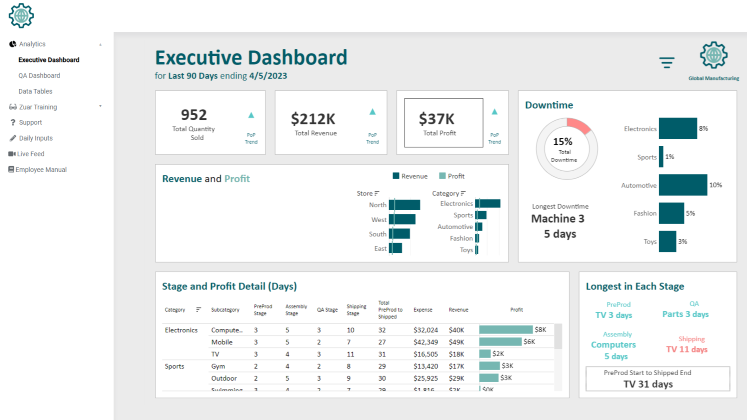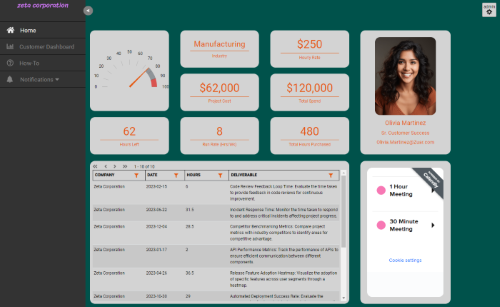What Is a Tableau Portal? Tools, Benefits & Case Study
Looking for a better way to share Tableau insights? Try implementing a Tableau Portal and centralize your data visualizations in one easily accessible location!

Introduction to Tableau Portals
Tableau is a powerful data visualization software that enables users to create interactive and shareable dashboards. It is widely used for business intelligence, allowing organizations to analyze data from various sources and make data-driven decisions.
So, what is a Tableau Portal? A Tableau Portal (AKA Tableau Customer Portal) is a customized web interface that integrates Tableau's data visualization capabilities into a unified, branded experience for users.
It allows organizations to provide secure access to interactive dashboards and reports, often personalized for different user roles, all within a centralized platform.
This enables clients or internal teams to easily access, explore, and interact with their data through a tailored portal, enhancing the user experience and ensuring that insights are readily available.
Overall, Tableau Portals make it easier to distribute analytics at scale and create a data-driven culture.
A prime example of a Tableau Portal is Zuar Portal. This plug-and-play platform connects to Tableau and provides streamlined access to Tableau visualizations to employees, clients, partners, and more.
Learn more about building a Tableau Customer Portal with Zuar:

Key Takeaways
- Tableau Portals provide a secure, centralized analytics platform for organizations to distribute insights at scale through self-service capabilities.
- Key benefits of Tableau Portals include improved analytics accessibility and collaboration, governance, security, branding, and accelerated data-driven decision making.
- The self-service model of Tableau Portals expands analytics availability so users can quickly access customized, trusted dashboards and reports.
Benefits of Tableau Portals
Tableau Portals offer many benefits to organizations and users. Some examples include self-service capabilities, centralized access to data insights, increased security and data governance, and enhanced customer experiences.

Self-Service Analytics
Tableau Portals empower business users with self-service analytics capabilities. Instead of relying on IT or data experts for reports and dashboards, business users can log into the portal and access analytics content tailored for their needs.
Some key benefits of self-service analytics with Tableau Portals:
- Faster insights - Users don't have to wait for someone else to create reports. They can quickly analyze data themselves to answer pressing business questions.
- Broader usage - More employees can leverage analytics, not just data experts. This democratizes data in the organization.
- User autonomy - Business users can explore data freely without being a burden on IT. They have the flexibility to slice data on their own.
- Customization - Users can tweak visualizations and dashboards to meet their specific needs. Self-service allows deeper personalization.
- Agility - With self-service, users can adapt faster to changing business requirements and modify analytics content accordingly.
The self-service model empowers users and makes analytics more agile. Tableau Portals provide an intuitive interface where business users of all skill levels can access and interact with trusted data sources to gain insights. This drives broader usage and faster time to value.
Centralized Access
Tableau Portals provide centralized access to an organization's data, metrics, and reports. Rather than having analytics content and assets spread out across file shares, local machines, or email inboxes, a Tableau Portal acts as a single hub.
This centralized access brings numerous benefits:
- Consistent availability of analytics content - Users can reliably access reports, dashboards, and data sources through the portal rather than tracking down files on someone's computer or in an email.
- Standardized distribution - New reports and dashboards can be published to the portal on a regular schedule for broad visibility rather than relying on emails or dealing with fragmented access.
- Improved discoverability - Users can search and browse portal content rather than guessing who created what. The portal acts as a catalog.
- Anywhere access - Since Tableau Portals are web-based, authorized users can access its contents from anywhere on any device. Analytics content is no longer trapped in physical locations.
- Role-based access - The portal provides the ability to define user roles with specific permissions to access and interact with content. This enhances security and allows more granular control over consumption.
Overall, Tableau Portals provide consistency for enterprise analytics content. Centralized access replaces fragmented, hard-to-manage distribution models that limit the impact of analytics investments.
Security and Governance
Tableau Portals provide robust security and governance capabilities to enable secure self-service analytics. With role-based access controls, admins can restrict data and content access to certain groups and users. This makes it easy to prevent unauthorized access.
Portal permissions and content permissions allow granular control over who can view, interact with, edit, publish, and administer both content and the portal itself.
Platforms like Zuar Portal provide single sign-on so users can securely access the portal with their existing credentials. Multi-factor authentication adds an extra layer of user identity verification.
Usage monitoring provides insight into user behaviors like content access, downloads, and subscriptions. Data lineage shows the flow of data from sources to workbooks to help understand the downstream impacts of changes.
With Tableau's robust security architecture and governance tools, organizations can safely expand analytics to more users through self-service portals while maintaining oversight, ensuring only authorized users get access to sensitive data.
Customer Experience
Companies that offer analytics to their clients can greatly benefit from implementing Tableau Portals. This added value bolsters your customer experience (CX).
Platforms such as Zuar Portal offer white-label capabilities allowing you to quickly build Tableau customer portals that replicate your unique look and feel.
As a no-code solution, Zuar Portal allows you to craft custom client portals with simple drag-and-drop tools. Offering a premier analytics experience to your customers increases customer retention and can provide opportunities for data monetization.
Take Zuar Portal for a spin by trying out our free demo:


Features of a Tableau Portal
Content management and alerts and subscriptions are two examples of typical Tableau Portal features.
Content Management
Tableau Portals provide robust content management capabilities to curate, organize, search, and recommend content. The portal acts as a centralized hub for publishing, sharing, and finding analytics content.
With Tableau Server or Tableau Cloud, users publish workbooks, views, and data sources, which become content within the portal. Content owners can add metadata like tags and descriptions to enable better search and discovery.
Content can be organized within projects to align with team structures or business functions. Users browse projects and content tailored specifically for them based on their access level.
Overall, Tableau Portals enable organizations to effectively manage analytics content at scale. The robust content management capabilities empower users to easily publish, organize, secure, discover, and consume trusted analytics content.
Alerts and Subscriptions
Configuring alerts and subscriptions in a Tableau Portal allows users to stay up-to-date on metrics, views, and workbooks that are important to them. Users can subscribe to views and workbooks to receive notification messages when the underlying data changes.
Administrators can set up alerts for the entire site or leave it to users to manage their own alerts. Alerts can be configured to monitor key metrics and send notifications when certain thresholds are met. This enables proactive data-driven monitoring.
Some examples of alerts in Tableau Portals include:
- Sales targets - receive an alert when regional or product sales hit a specified target
- Data refresh alerts - get notified when a key data source has refreshed
- Metric thresholds - configure alerts when KPIs go above or below defined levels
- View and workbook updates - subscribe to changes to views and workbooks to stay on top of your most important dashboards
Proper setup of alerts and subscriptions helps users stay on top of changes without having to manually check dashboards repeatedly. Well-configured notifications enable a more proactive and data-driven organization.

Tableau Portal Case Study
4Atmos Technologies, seeking to improve how they delivered web visualizations and dashboards to clients, opted to create Tableau customer portals through Zuar Portal.
Previously relying on email for reporting, 4Atmos needed a more effective solution for live analytics and three-dimensional modeling.
By implementing the Zuar Platform, they automated data preparation for Tableau and created a web portal offering clients instant access to personalized, live dashboards.
This collaboration enabled 4Atmos to catch over 2,000 mechanical failures before they occurred, significantly reducing downtime for their rail customers and boosting client satisfaction.
Watch the full case study video:


Implementation
Deploying a Tableau Portal requires careful planning and preparation. Here are some key steps:
- Determine Deployment Method - Decide whether to host Tableau on-premises or in the cloud. On-prem allows more customization and control, while the cloud offers faster setup and reduced maintenance. Consider bandwidth requirements, security policies, and IT resources.
- Configure High Availability - For mission-critical portals, set up high availability with load balancing, failover, and redundancy. Use Tableau Server clustering, database replication, virtual IPs, etc.
- Customize and Brand - Customize branding, theming, logo, colors, and messaging to match internal site standards. Set up custom email templates. Configure landing pages and menus.
- Migrate Content - Migrate existing reports, dashboards, data sources, and content from current tools into the new portal. Establish governance for content publishing workflows.
- Train Users - Educate end users on new self-service capabilities. Set up training sessions and provide user guides. Establish power users as first adopters and mentors.
- Launch and Iterate - Pilot the portal with a small group, then roll out more widely. Gather feedback to refine the portal and expand functionality. Continuously enhance the portal over time.

Adoption Strategies
Driving user adoption of Tableau Portals in organizations requires a multi-faceted approach. Here are some key strategies:
Executive Sponsorship
Having an executive sponsor who evangelizes the value of the Tableau Portal is crucial. They can communicate the benefits, align usage to business goals and data strategy, and dedicate resources to training and change management. The sponsor should be a senior leader who can motivate adoption from the top-down.
Training
Provide training resources and documentation tailored to different user personas. Hands-on workshops with real business examples are ideal.
Consider creating power users as evangelists who can provide peer coaching. Training increases confidence in using the platform.
Promote Wins
Publicize business successes enabled by Tableau Portals through internal communications. Showcase teams that have created impactful dashboards or leveraged new insights.
Highlight power users sharing their "aha" moments. Promote wins to gain grassroots enthusiasm.
Usage Mandates
Require teams to use the Tableau Portal for key processes like performance dashboards, reporting, and analysis. This top-down mandate signals the importance of adoption. However, it should be combined with training and support.
Incentives
Consider tying usage metrics or training completion to incentives. Individual recognition or team rewards can spur engagement. Dashboards of the month/quarter competitions also tap into intrinsic motivation.
Ongoing Community
Build a community forum for users to interact, share best practices, and get assistance. Community builds camaraderie and reinforces usage. Consider user conferences and social channels as well.
Iteration
Continuously gather user feedback to refine the portal and enhance the user experience. Address pain points through new features, modifications, and content. User-centric iteration will drive ongoing engagement.

The Ultimate Tableau Portal Solution
Tableau Portals provide a secure, centralized platform for organizations to make data driven decisions and foster a culture of self-service analytics.
If you're looking to take your Tableau game to the next level, it's clear that a Tableau Portal is the way to go. However, choosing the one that suits your business best can be tough.
This is where Zuar Portal stands out. Its white-label BI tools and centralized platform make it incredibly easy to integrate and customize.
By streamlining analytics and workflow, Zuar Portal empowers you to deliver personalized, data-driven experiences that enhance customer satisfaction and loyalty.
With a seamless user experience and rock-solid security, Zuar Portal is truly the ideal Tableau Portal for businesses that want to level up their data game.
Start a free two-week free trial to try it out and get a look under the hood!



